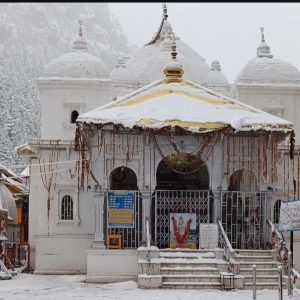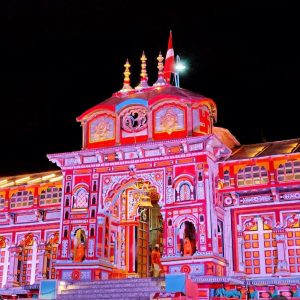About Kedarnath Temple
Kedarnath Temple is one of the sacred pilgrimage centre located in the Rudra Himalaya range of Uttarakhand State in the Northern part of India, located on the bank of the Mandakini river at an altitude of 3584 meters above the sea level. The temple is dedicated to Lord Shiva. There are more than 200 shrines dedicated to Lord Shiva in Chamoli district of Uttarakhand itself, in that the most important one is Kedarnath.
According to the legend, the Pandavas after having won over the Kauravas in the Kurukshetra war, felt guilty of having killed their own Kin and sought blessings of Lord Shiva for redemption. He eluded them repeatedly and while fleeing took refuge at Kedarnath in the form of a bull. On being followed, the Lord dived into the ground, leaving his hump on the surface at Kedarnath. The remaining portions of Lord Shiva appeared at four other places and are worshipped there as his manifestations. The arms of the Lord appeared at Tungnath, the face at Rudranath, the belly at Madmaheshwar and his locks (hair) with head at Kalpeshwar. The Kedarnath and four above mentioned shrines are treated as Panch Kedar (Panch means Five in Sanskrit).
The historical name of this region is “Kedar Khand”. Kedarnath temple is a part of Char Dhams and Panch Kedar in Uttarakhand and one of the 12 Jyotirlingas of Lord Shiva in India.
The temple was originally built in 8th century A.D. by Jagad Guru Adi Shankaracharya and stands adjacent to the site of an even earlier temple built by the Pandavas. The Temple at Kedarnath presents an imposing sight, standing in middle of a wide plateau surrounded by lofty snow covered peaks. The Kedarnath temple has an exquisite architecture. The inner walls of the hall are decorated with figures of various deities and scenes from mythology. Outside the temple door a large statue of the Nandi stands as the guard. A conical rock formation inside the temple is worshipped as Lord Shiva in his Sadashiva form.
Kedarnath experiences heavy Snowfall in Winter upto several metres. The temple itself is blanketed with snow from November to April. So, at the onset of Winter every year, which is normally in the First week of November and on an auspicious date which is announced in advance, the holy symbolic statue of Lord Shiva is carried down from Kedarnath temple to a place called Ukhimath, where it is worshipped as Lord Shiva. The pujas and archanas are done at Ukhimath from November till May of next year. In the first week of May and on an auspicious date which is announced in advance, the symbolic statue of Lord Shiva is carried back from Ukhimath to Kedarnath and reinstated in the original place. It is at this time, that the doors of the temple are thrown open to pilgrims, who flock from all parts of India, for a holy pilgrimage. The shrine generally closes on the first day of Kartika masam (Oct-Nov) and reopens in Vaishakha masam (Apr-May) every year.
Best Time To Visit Kedarnath Temple
May, June, July, August, September, October, November
Pujas Performed In kedarnath Temple
Weather In Kedarnath Temple
Winter (October to April): Snowfall is very common and minimum can touch sub zero levels. Not the perfect time for travelling.
Summer (May to June): Very pleasant with moderately cold climate. Ideal for all sight seeing and the holy Kedarnath pilgrimage.
Monsoon (July to mid-September: Regular rains and also temperature drops down. The region is prone to occasional landslides. Travelling can be difficult.
How To Reach Kedarnath Temple
By Air: Jolly Grant Airport (35 kms from Dehradun) is the nearest Airport to Kedarnath situated at a distance of 235kms. Jolly Grant Airport is well connected to Delhi with daily flights. Gaurikund is well connected by motorable roads with Jolly Grant Airport. Taxis are available from Jolly Grant Airport to Gaurikund.
By Train: The nearest railway station to Gaurikund is Rishikesh. Rishikesh railway station is situated 243kms before Gaurikund on NH58. Rishikesh is well connected by railway networks with major destinations of India. Trains to Rishikesh are frequent. Gaurikund is well connected by motorable roads with Rishikesh. Taxis and buses are available from Rishikesh, Srinagar, Rudraprayag, Tehri and many other destinations to Gaurikund.
By Road: Gaurikund is well connected by motorable roads with major destinations of Uttarakhand state. Buses to Haridwar, Rishikesh and Srinagar are available from ISBT Kashmiri Gate New Delhi. Buses and Taxis to Gaurikund are easily available from major destinations of Uttarakhand state like Dehradun, Haridwar, Rishikesh, Pauri, Rudraprayag, Tehri etc. Gaurikund is connected with Ghaziabad by National Highway 58.
Self Drive: Drive to Gaurikund (approximately 220 km from Haridwar). Beyond Gaurikund, trek or use alternative transport.
Kedarnath Route from Delhi:
By Road (Taxi or Self-Drive): Delhi → Haridwar/Rishikesh → Rudraprayag → Augustmuni → Guptkashi → Gaurikund. Park vehicle at Gaurikund and trek to Kedarnath.
By Helicopter: Flight to Dehradun’s Jolly Grant Airport. Drive to helipad at Phata, Sersi, or Guptkashi. Board helicopter to Kedarnath.
By Train: Delhi to Haridwar/ Rishikesh and then follow the road route.
Address
Kedarnath Temple, Kedarnath, Rudraprayag district, Uttarakhand 246445
Also Read About Temple Official Website
Hotels




Post Discussion